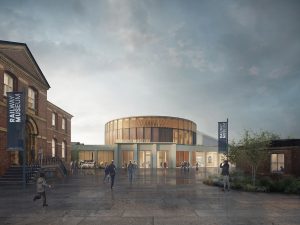Museum announces £16.5m sustainable design

Architectural practice Feilden Fowles has won a competition to create York’s National Railway Museum’s £16.5m Central Hall building – a key part of the museum’s Vision 2025 masterplan.
The building will celebrate and showcase the latest developments in railway technology, provide a world-class visitor entrance and be an exemplar of low-carbon and sustainable architecture.
Feilden Fowles beat 75 other teams to the commission for the 48,437 sq ft Central Hall.
The competition jury, chaired by Dame Mary Archer, praised the winning team’s proposal for its “elegant but functional design” as well as its ambitious energy strategy.
Inspired by the site’s former use as working railway buildings, the designs featured in the proposal reference the history of locomotive ‘roundhouses’ with a central two-storey rotunda.
Clad in recycled copper and featuring high, glazed ceilings with timber radials, the building will attract visitors approaching from the city centre and York Station.
The proposal – which will be shaped by the museum and the winning team – dramatically reduces reliance on concrete and steel by creating a timber frame structure.
A combination of passive design principles and active systems, including the use of recycled copper and local stone, will reduce the site-wide operational carbon footprint by 80%.
Central Hall will be the centrepiece of the museum’s masterplan and will include a 10,763 sq ft gallery to showcase the future of railway technology.
Judith McNicol, director of the National Railway Museum, said: “The winning design centres around a beautifully crafted timber frame rotunda which, through the use of recycled and locally sourced materials, will dramatically reduce the museum’s carbon footprint.
“Feilden Fowles demonstrated a real sensitivity to the site’s railway heritage and to the historic character of the city of York.
“The building will play a vital role in linking the museum and will provide a focal point for the wider York Central development.
“We were delighted to share all the finalists’ shortlisted design concepts both online and at the museum. This gave us a real sense of the incredible enthusiasm the public have for our vision to become the world’s railway museum.”
The masterplan is the cultural anchor of York Central – one of the largest brownfield regeneration projects in Europe.
York Central has received outline planning permission and received £77.1m of Government investment earlier this month. York Central will see the creation of a new park and green spaces as well as creating up to 2,500 homes and an additional 6,500 jobs.
Dame Mary Archer, chair of the Board of Trustees, Science Museum Group and chair of the Strategic Board, York Central, said: “Whilst the unprecedented challenge of the coronavirus is dominating our lives, we all want to see hope and ambition beyond the present dangers.
“So we are holding steady with our ambition to make this the world’s greatest railway museum.
“If anything, the wider situation has strengthened the resolve of the Science Museum Group to move forward with our transformational plans for our five sites outside London, investing in a sustainable future and playing our part in keeping culture at the heart of our communities.”
Feilden Fowles’ design concept was developed with fellow team members, Max Fordham MEP (Services) Engineer and Price and Myers Structural and Civil Engineers.
Fergus Feilden, director of Feilden Fowles, said: “We’re thrilled to win this nationally significant competition.
“The brief combined three of our passions – museum architecture, great railway architecture of the 19th century and working in Yorkshire.
“Central Hall is both a tremendous challenge and a unique opportunity to create a new face and connected experience for the museum. We can’t wait to start work with such a fantastic client.”
Seventy-six teams comprising 241 firms from 19 countries entered the competition, which launched in September 2019.
The National Railway Museum is among the most popular attractions in the UK and welcomes more than 700,000 visitors annually.









